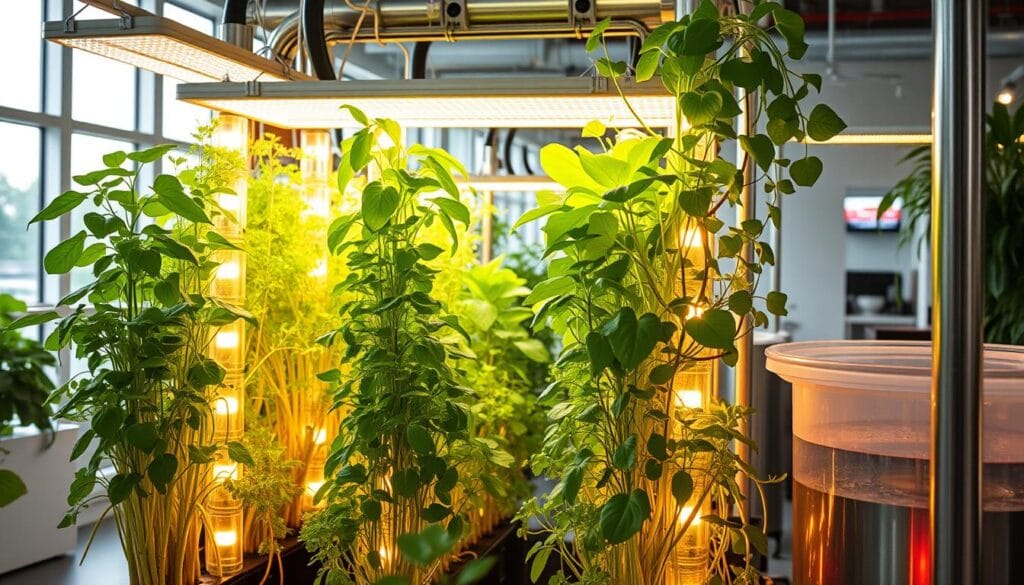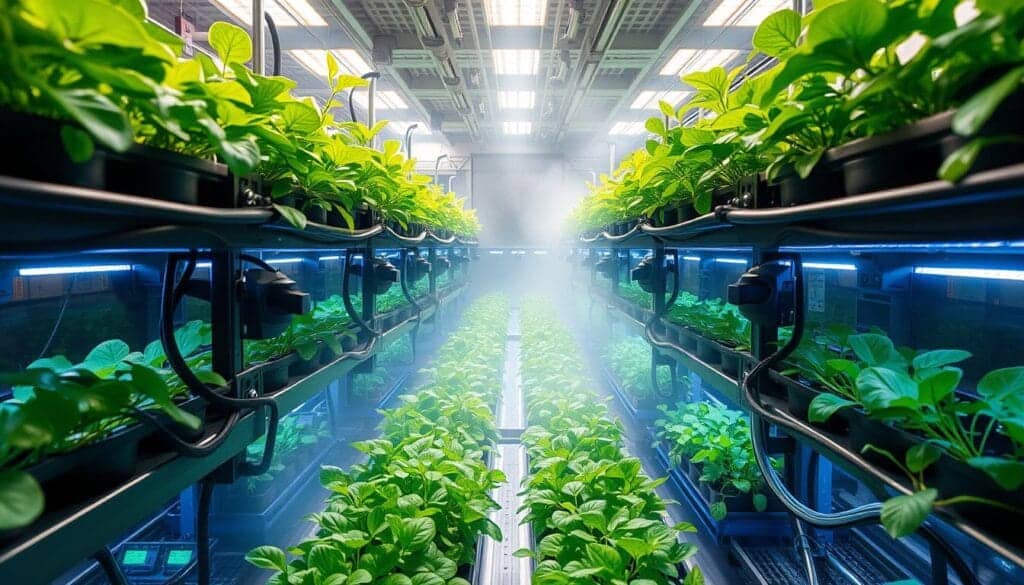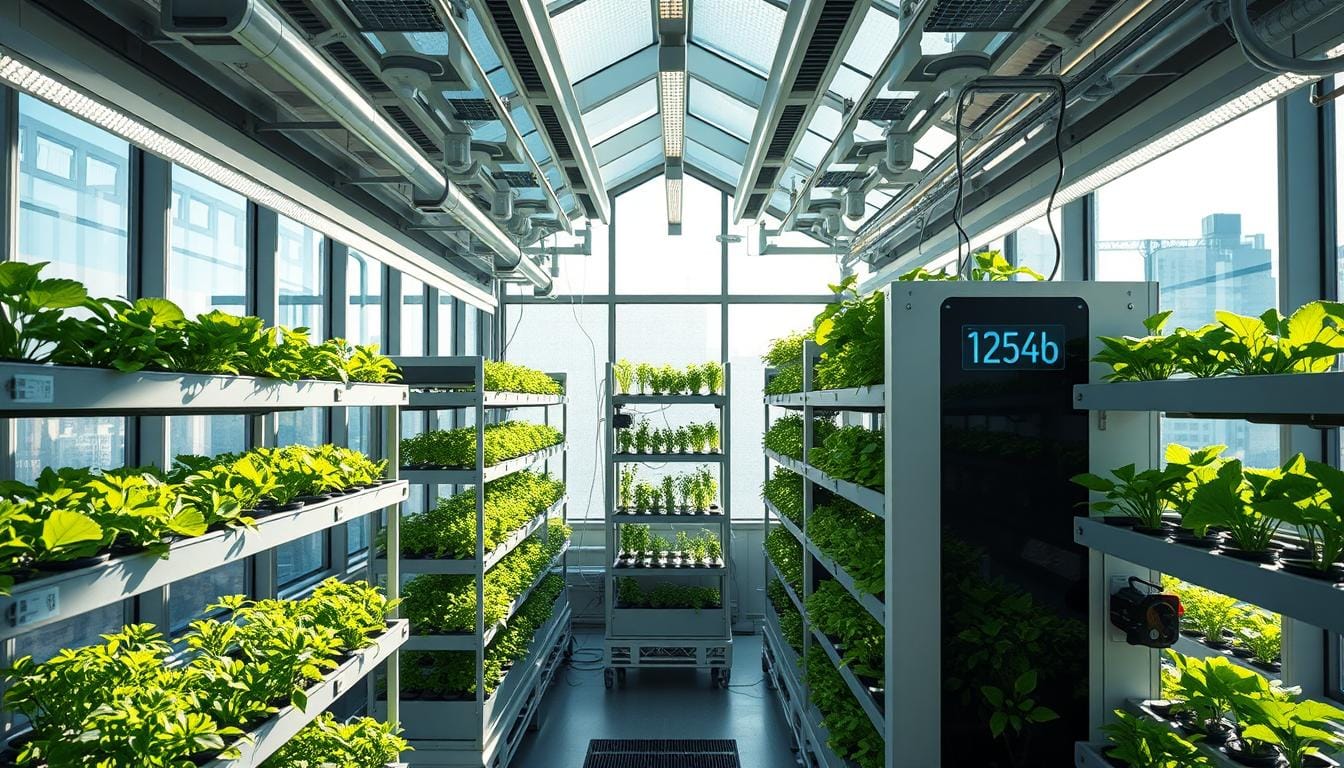Exploring gardening, you might find automated hydroponic systems. They’re changing how we grow plants, making it simpler and more efficient. These systems help you develop more, save water, and work less.
This guide will explain why automated hydroponic systems are key in gardening and farming. They help you reach your gardening goals, whether new or experienced. Automated hydroponic systems elevate your gardening to new heights.
Introduction to Automated Hydroponic Systems
Automated hydroponic systems make gardening easier and more productive. They use tech to control growing conditions, giving plants the right nutrients and light. You can grow many plants, from greens to fruits and veggies.
Key Takeaways
- Automated hydroponic systems are revolutionizing modern hydroponic gardening.
- These systems increase crop yields, conserve water, and reduce labor.
- Automated hydroponic systems use advanced technology to monitor and control growing conditions.
- You can grow a wide variety of plants with automated hydroponic systems
- Automated hydroponic systems are perfect for seasoned gardeners and beginners alike
- These systems are designed to make hydroponic gardening easier, more efficient, and productive
Understanding Automated Hydroponic Systems: A 2025 Perspective
Exploring hydroponic gardening reveals the perks of automated systems. These systems change how we grow plants, making care easier. They ensure plants get the right nutrients, water, and light for the best growth and yields.
Automated systems include sensors, control systems, and nutrient delivery. These parts work together for a smooth growing space. For example, sensors check pH, temperature, and humidity. Control systems adjust nutrients and light for your plants’ needs.
What Makes a Hydroponic System “Automated”
An automated hydroponic system does tasks on its own. This includes watering, nutrient delivery, and pruning. Technology like timers, sensors, and control systems makes this possible. Automation saves time and effort, making system management simpler.
Key Components of Modern Automated Systems
Modern automated hydroponic systems have:
- Sensors to monitor pH, temperature, and humidity levels
- Control systems to adjust nutrient levels and lighting
- Nutrient delivery mechanisms to provide optimal nutrition
- Automated pruning and training systems to promote healthy growth
Benefits of Automation in Hydroponics
Automation in hydroponics offers many advantages. With an automated system, you can expect:
- Increased efficiency and reduced labor
- Improved crop yields and quality
- Enhanced precision and control over growing conditions
- Reduced waste and optimized resource use
Choosing the Right Automated System for Your Needs
Choosing the right automated gardening solutions for hydroponic farming can be tough. You must think about space, budget, and the crops you want to grow. It’s key to match your needs with the capabilities of different systems.
Space is very important. It decides how big your system can be. If space is tight, a compact or vertical system might be best. But, if you have lots of space, you can choose a bigger system for more crops.
Here are some key factors to consider when choosing an automated system for your hydroponic farming needs:
- Initial investment and ongoing costs
- Type and variety of crops to be grown
- Level of automation and control required
- Scalability and flexibility of the system
By carefully evaluating these factors and considering your specific needs, you can choose an automated gardening solution that will help you achieve success in your hydroponic farming endeavors. Whether you’re a seasoned farmer or a beginner, the right automated system can make all the difference in the quality and quantity of your crop yields.
Essential Components and Technology Integration
Creating an efficient hydroponic system starts with the right equipment. Smart hydroponics combines different parts and tech to help plants grow better and reduce work. A well-designed system means more crops, less water and nutrients, and a greener growing space.
Sensors and Monitoring Equipment
Sensors and monitoring tools are key in smart hydroponics. They help track things like temperature, humidity, and pH levels. This info lets you adjust nutrients, light, and climate for the best plant growth.
Control Systems and Software
Control systems and software are the heart of smart hydroponics. They let you automate and manage your system. From feeding nutrients to controlling light and climate, these tools help you care for your plants better.
Some important features of these systems include:
- Automated scheduling and dosing of nutrients
- Real-time monitoring of temperature, humidity, and pH levels
- Adjustable lighting schedules and spectra
- Integration with sensors and monitoring equipment
Using these technologies, you can make a hydroponic system that’s efficient and productive. It cuts down on waste and boosts yields, all while being kinder to the environment.
Setting Up Your First Automated Hydroponic Garden
To start your automated hydroponic garden, prepare the growing area and build the system. This means setting up the hydroponic technology and starting the automated parts. First, pick a good spot for your garden. It should get enough light and have a steady power source.
Then, put the system together as the maker says. This usually means linking the reservoir, pumps, and pipes. Always be careful with electrical parts. After setting up, start the automated nutrient delivery system. It will give your plants the nutrients they need to grow well.
Here are some important steps for setting up your automated hydroponic garden:
- Prepare the growing area and assemble the system
- Initialize the automated components, including the automated nutrient delivery system
- Monitor and adjust the system as needed to ensure optimal plant growth
By following these steps and using the latest hydroponic technology, you can make a great automated hydroponic garden. Always check the system and tweak it if needed. This will help your plants grow well and stay healthy.

Smart Monitoring and Control Systems
Exploring automated grow systems means understanding the importance of smart monitoring and control. These systems help optimize your hydroponic garden’s performance. With smart hydroponics, you can manage your garden remotely, ensuring the best-growing conditions and higher yields.
Mobile apps and remote management let you keep an eye on your garden’s health. You get updates and alerts for any changes in temperature, humidity, or nutrient levels. This way, you can make informed decisions to improve growth.
Key Benefits of Smart Monitoring
- Real-time monitoring and control of your hydroponic garden
- Data analytics for optimal growth and yield optimization
- AI-powered growth optimization for personalized recommendations
Automated grow systems and smart hydroponics take your garden to new heights. You’ll see better efficiency, productivity, and yields. Data analytics and AI help you grow healthier, more resilient plants easily.
Embracing smart monitoring and control systems leads to a thriving, automated hydroponic garden. It will produce outstanding results, season after season.
Automated Nutrient Management and pH Control
Exploring hydroponics, you’ll find automated nutrient delivery key to a healthy garden. The right hydroponic equipment ensures your plants get the nutrients they need. This leads to better growth and more yields.
Many systems use sensors and monitoring tools to keep nutrient and pH levels just right. This precise control helps you make informed decisions for your plants’ growth.
- Improved crop yields and quality
- Reduced waste and environmental impact
- Increased efficiency and reduced labor costs
Investing in top-notch hydroponic equipment and an automated nutrient delivery system boosts your garden. You’ll see better productivity and healthier plants.
Advanced Climate Control and Environmental Optimization
Exploring automated hydroponic systems shows how key climate control is for plant growth. With top-notch hydroponic tech, you can make a perfect spot for your plants to grow. Automated gardening lets you control temperature, humidity, and CO2 levels precisely, giving your plants the best conditions.
Temperature management is vital for plant growth. Automated systems keep the temperature just right, which is key for healthy plants. This is done with smart temperature systems, like thermostats and heaters or coolers. Keeping the right temperature helps plants grow strong roots, avoid diseases, and boost yields.
Humidity Control Solutions
Humidity control is also key in automated hydroponics. It stops problems like fungal diseases and root rot. Automated systems use smart sensors and control systems to keep humidity levels just right, giving plants the right moisture.
CO2 Regulation Technologies
CO2 control is important for plant growth, as it affects photosynthesis. Automated systems watch and adjust CO2 levels, making sure plants get the right amount. Adding CO2 control tech to your system can make plants grow faster, increase yields, and improve health.
Using these advanced climate control and environmental optimization methods in your automated hydroponic system can create a great environment for your plants. With the right mix of hydroponic tech and automated gardening, you can make your plants grow amazingly well and get great results.
Troubleshooting Common Issues in Automated Systems
Starting with hydroponic farming and indoor systems, you might face some common problems. These can slow down your plants’ growth and productivity. First, check the system’s sensors and monitoring tools to make sure they work right.
In indoor systems, temperature changes are a big worry. If the temperature is off, it can harm your plants. Use thermometers and heaters or coolers to keep the temperature steady. Also, keep an eye on pH levels and adjust them often to protect your plants.

- Clogged nutrient delivery systems
- Malfunctioning pumps or aerators
- Incorrect pH or nutrient levels
- Insufficient or excessive lighting
Fixing these problems quickly helps avoid long-term damage to your plants. This way, you can have a healthy and fruitful harvest in your hydroponic or indoor system.
Regular maintenance and monitoring are key to solving common issues in automated hydroponic systems. By keeping up with these tasks, you can have a successful and rewarding growing experience.
Maximizing Yield with Data-Driven Techniques
As you get better at hydroponic gardening, using data and analytics is key. It helps you get the most out of your automated hydroponic systems. By looking at growth patterns, you can make your garden more productive.
In automated hydroponic systems, data is very important. It helps you find ways to improve. You can use sensors to track things like temperature and nutrient levels. This lets you make smart choices for your garden.
Growth Pattern Analysis
This means studying how your plants grow and change over time. By looking at this data, you can learn what works best for your plants. For example, you might find that certain conditions help them grow better.
Yield Optimization Strategies
After you’ve looked at your growth patterns, you can start making plans to get more from your garden. You might adjust your system to give your plants the best conditions. You can also pick the best plants for your garden based on data.
Resource Efficiency Improvements
Data can also help you use resources better in your garden. By watching how you use water and nutrients, you can cut down on waste. This benefits the environment while also saving money.
By using data and the features of automated hydroponic systems, you can take your gardening to new heights. You’ll get more from your garden, use resources better, and make gardening more sustainable.
| Technique | Description | Benefits |
|---|---|---|
| Growth Pattern Analysis | Studying growth rates, yields, and health of plants | Inform decision-making, optimize growing conditions |
| Yield Optimization Strategies | Adjusting automated hydroponic systems for optimal yields | Increase productivity, reduce waste |
| Resource Efficiency Improvements | Monitoring and optimizing resource usage | Reduce waste, minimize environmental impact |
Sustainable Practices in Modern Hydroponics
Exploring hydroponics shows us how important sustainable practices are. They help us reduce our environmental impact. Using energy-saving hydroponic gear and smart growing methods cuts down our carbon footprint. This makes our growing systems more eco-friendly.
Water conservation is a big part of sustainable hydroponics. This is done with advanced irrigation and precise nutrient delivery.
Here are some ways to make your hydroponic system greener:
- LED grow lights use less energy than old lighting methods.
- Recirculating systems cut down water waste.
- Using eco-friendly nutrients avoids harsh chemicals.
By adopting these practices, you can grow great crops and help the planet. The right equipment and techniques let you enjoy indoor gardening without harming the environment.
Remember, sustainability is vital for a successful, eco-friendly hydroponic system. Simple changes can make a big difference. They help us garden more sustainably.
Conclusion: Embracing the Future of Automated Hydroponic Growing
The future of growing food is looking bright with automated systems. These systems make farming more precise, efficient, and kind to the planet. You can now grow lots of food with less effort and fewer resources.
These systems use advanced sensors and data to help your plants thrive. They manage nutrients and control the climate for you. This means you can grow more food with less work and less harm to the environment.
By using these systems, you open up new ways to grow food. Technology and nature can work together to feed our communities better. Start growing your food in a way that’s good for the planet and you.

